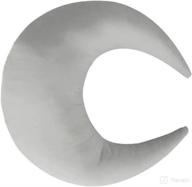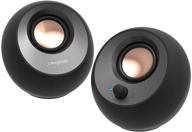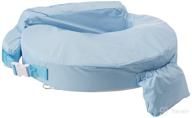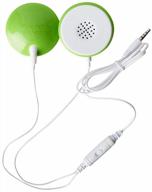Another interesting products


8 Review



9 Review

Introduction to Prenatal Monitoring Devices
Prenatal monitoring devices are tools used during pregnancy to track the health and development of the fetus. They allow expectant mothers and medical professionals to monitor the baby's vital signs, movement, and overall wellbeing throughout pregnancy.
Top products in 🤰🏻 Prenatal Monitoring Devices


8 Review

Types of Prenatal Monitoring Devices
There are several different types of prenatal monitoring devices:
- Doppler Devices - Use ultrasound technology to detect fetal heartbeat. Handheld models are available for home use.
- Electronic Fetal Monitors - Monitor baby's heart rate and mother's contractions. Used in medical settings.
- Telemonitoring - Allows remote monitoring and data transmission to medical staff.
- Uterine Contraction Monitors - Track frequency and duration of contractions. Help identify preterm labor.
When Prenatal Monitoring Occurs
Prenatal monitoring typically begins around 10-12 weeks into the pregnancy. Monitoring becomes more frequent and involved as pregnancy progresses:
- First Trimester - Heartbeat detected via Doppler. Uterine and blood pressure monitoring if high risk.
- Second Trimester - Heartbeat, movement checks. Biophysical profile later in trimester.
- Third Trimester - Regular nonstress tests, biophysical profiles to check fetal wellbeing.
Benefits of Prenatal Monitoring
Regular prenatal monitoring provides many benefits including:
- Detects fetal heartbeat and confirms pregnancy is progressing normally.
- Tracks baby's growth, movement patterns, and heart rate.
- Monitors contractions and helps identify preterm labor risk.
- Identifies potential problems like restricted growth or distress.
- Provides reassurance about baby's wellbeing.
Considerations for Use
Some tips for expecting mothers using prenatal monitoring devices:
- Follow manufacturer instructions carefully.
- Communicate worries or decreases in movement to your doctor.
- Avoid overusing handheld Doppler devices.
- Understand these tools have limitations.
- Never use results to replace medical care.
When used properly under medical guidance, prenatal monitoring devices provide vital information about fetal health and the progression of pregnancy.
Types of Prenatal Monitoring Devices
There are several types of prenatal monitoring devices used to track fetal health and the mother's progress during pregnancy:
Doppler Devices
Doppler devices use ultrasound technology to detect the fetal heartbeat and monitor the heart rate. There are two main types:
- Fetal Doppler - Handheld doppler used at home to listen to baby's heartbeat. Provides reassurance between prenatal visits.
- Ultrasound Doppler - Used by medical professionals to check the fetus during office visits. Provides audio of heartbeat.
Similar products


27 Review

Electronic Fetal Monitors
Electronic fetal monitors (EFM) simultaneously track the baby's heart rate and the mother's contractions. There are two types:
- External EFM - Belts placed around the abdomen to monitor heart rate and contractions externally.
- Internal EFM - Small electrode inserted through the dilated cervix to monitor heart rate from inside the uterus.
Uterine Contraction Monitors
These devices track the timing and duration of uterine contractions. Types include:
- Tocodynamometer - Belt with sensor to monitor intensity, frequency and duration of contractions.
- Intrauterine Pressure Catheter - Catheter inserted into the uterus to directly measure pressure changes.
Telemetry Monitoring
Telemetry fetal monitoring uses wireless technology to remotely monitor the fetus and transmit data. This allows mobile monitoring.
Maternity Belts
Belts worn around the abdomen to hold monitoring devices in place. Available in disposable and reusable options.
Wearable Sensors
Small, wireless patch sensors worn on the abdomen to monitor uterine activity and fetal heart rate remotely.
Summary Table
| Device | Method | Use |
|---|---|---|
| Doppler | Ultrasound | Heartbeat detection |
| EFM | Sensors | Heart rate & contractions |
| Contraction Monitor | Sensors | Contraction tracking |
| Telemetry | Wireless transmission | Remote monitoring |
A variety of prenatal monitoring devices are available to help ensure a healthy pregnancy. Selection depends on specific monitoring needs.
Electronic Fetal Monitors
Electronic fetal monitors (EFM) are devices used during pregnancy to monitor the fetus's heart rate and the mother's uterine contractions. There are two main types:
External EFM
External EFM uses belts placed around the abdomen. One belt uses Doppler ultrasound to detect the fetal heartbeat. The other belt has a pressure sensor to monitor contractions.
- Noninvasive method to check on baby's wellbeing during labor.
- Belts are adjusted to get a good signal on baby's heart rate.
- Can continuously monitor the baby for signs of distress.
- Provides printout of heartbeat patterns and contraction frequency.
- Example: The nurse adjusted the EFM belts every hour during Michelle's labor to keep good contact on the skin.
Internal EFM
Internal EFM uses an electrode attached to the fetus's scalp through the dilated cervix. It offers a more accurate and direct heart rate reading than external monitoring.
- Small wire electrode inserted through vagina and cervix onto baby's scalp.
- Can provide better heart rate signal if external monitor having trouble.
- Allows for mobility during labor since it's not belted on.
- Example: During prolonged labor, an internal EFM was placed to get an accurate tracing of the baby's heartbeat.
Using Electronic Fetal Monitoring
EFM is commonly used in delivery rooms to monitor high-risk pregnancies and when labor is induced. Guidelines include:
- EFM recommended for high-risk pregnancies and complications.
- Intermittent EFM often used in low-risk pregnancies.
- Internal EFM only used when medically warranted by doctor.
- Not continually needed for low-risk, normal vaginal deliveries.
- Printouts assessed at intervals to monitor any concerning changes.
EFM provides valuable information on the fetus's condition during the stress of labor. It helps medical staff identify early signs of fetal distress and intervene appropriately.
Uterine Contraction Monitors
Uterine contraction monitors are devices used during pregnancy and labor to track the frequency, duration, and intensity of contractions. The two main types are:
Tocodynamometer
This belt-like contraction monitor uses a strain gauge sensor placed on the abdomen. It detects pressure changes associated with contractions and provides a paper tracing of the contraction pattern.
- External belt strapped around the abdomen to passively monitor contractions.
- Sensor picks up hardness of abdomen during contractions.
- Shows contraction frequency, length, and relative strength/intensity.
- Example: The nurse used a tocodynamometer belt to continuously monitor Jessica's contractions during induction.
Intrauterine Pressure Catheter
This internal catheter directly measures changes in uterine pressure during contractions. It is inserted through the vagina into the uterus.
- Catheter inserted into uterus to directly record pressure changes.
- Considered more accurate than external monitoring.
- Useful for high-risk pregnancies or when labor patterns concerning.
- Example: Jennifer required an intrauterine catheter to closely analyze her contraction pattern when labor stalled.
Using Contraction Monitors
Guidelines on using contraction monitoring include:
- Tocodynamometer belt commonly used for continuous external monitoring.
- Internal catheter only used when precise measurement is medically necessary.
- Monitoring helps identify preterm labor patterns.
- Can also alert doctors to situations like labor stalling or distress.
- Printout assessed at intervals for concerning changes.
Uterine contraction monitoring provides obstetricians with crucial information about the progression and intensity of labor. It helps medical staff identify potential problems and intervene in a timely manner.
Benefits of Using Prenatal Monitoring Devices
Prenatal monitoring devices provide many benefits for expecting mothers and medical professionals during pregnancy. The main benefits include:
Detect Fetal Heartbeat
Prenatal monitors like dopplers and ultrasounds allow detection of the fetal heartbeat as early as 10-12 weeks. This confirmation of a healthy heartbeat provides reassurance that the pregnancy is progressing normally.
Track Baby's Movement
Monitoring devices can track baby's kick counts, sleep cycles, and overall movement patterns. Decreases in expected movement can indicate potential problems requiring medical attention.
Monitor Contractions
Contraction monitors help identify premature labor by tracking the timing, length, and frequency of contractions. This allows early interventions such as hydration and medication to stop preterm labor.
Identify Potential Problems
Devices like EFM can detect signs of fetal distress like drops in heart rate during labor. Identifying problems early prevents complications and allows time for interventions.
Provide Reassurance
Normal readings from monitors offer expecting mothers peace of mind that their baby is healthy and developing on track. This can reduce pregnancy anxiety.
When used properly, prenatal monitoring devices offer valuable information about fetal wellbeing and the progression of pregnancy. This empowers medical staff to intervene promptly when any abnormalities arise.
Detecting Fetal Heartbeat
One of the main benefits of prenatal monitoring devices is their ability to detect the fetal heartbeat early in pregnancy. This provides reassurance that the pregnancy is progressing typically.
When Fetal Heartbeat First Detected
The fetal heartbeat can first be detected at around 5-6 weeks gestation using a transvaginal ultrasound. More commonly, it is detected between 10-12 weeks using an abdominal ultrasound or Doppler device.
- 5-6 weeks - Transvaginal ultrasound earliest detection
- 10-12 weeks - Abdominal ultrasound detection possible
- 12+ weeks - Home Doppler devices can detect heartbeat
Importance of Detecting Heartbeat
Detecting the heartbeat is a milestone that indicates the pregnancy is advancing as expected. Benefits include:
- Confirms pregnancy is viable and embryo developing normally
- Provides emotional reassurance to parents
- Establishes due date range
- screens for potential issues like ectopic pregnancy
Methods for Detection
Heartbeat detection methods include:
- Doppler Ultrasound - Most common. Uses sound waves to hear heartbeat.
- Abdominal Ultrasound - Visualizes embryo and heartbeat.
- Vaginal Ultrasound - Earlier detection than abdominal option.
- Fetal Doppler - Portable home units to listen to heartbeat.
Detecting the fetal heartbeat is a significant milestone in pregnancy and indicates the embryo is developing appropriately. It offers parents reassurance and establishes health baselines for further monitoring.
Tracking Baby's Movement
Monitoring fetal movement patterns is an important part of prenatal care. Changes or decreases in expected movement can signal potential problems requiring medical intervention.
Methods of Tracking Movement
Methods of tracking fetal movement include:
- Kick counts - Tallying active time periods
- Ultrasound - Visualizing real-time movement
- EFM - Monitoring heart rate accelerations in response to motion
- Maternal tracking - Logging time of active/quiet periods
Importance of Monitoring Movement
Tracking motion is important because:
- Decreased movement can indicate fetal distress
- Changes in pattern may reflect problems like lack of oxygen
- Daily movement signifies baby is active and healthy
Taking Action on Changes
If alterations in normal movement patterns occur, actions include:
- Increasing hydration and avoiding stimulants
- Changing positions to stimulate movement
- Counting kicks over an hour
- Going to the hospital for monitoring if concerns persist
Example: Amy noticed the baby was less active than normal. After drinking juice and lying on her left side, she felt 10 movements within an hour and called her doctor.
Careful monitoring of fetal movement provides insight into the baby's wellbeing and allows early intervention when any abnormalities occur.
"Top 6 Prenatal Monitoring Devices For A Healthy Pregnancy"
Top 6 Prenatal Monitoring Devices for a Healthy Pregnancy
- Baby Doppler Sonoline B Baby Heartbeat Tracker
- Mission Urinalysis Reagent Strips
- Care Touch Blood Glucose Testing Kit
- Wearable technology for health monitoring during pregnancy
- External fetal heart monitoring
- Internal fetal heart monitoring
Prenatal monitoring devices are essential for keeping track of your baby's health and ensuring a healthy pregnancy. The Baby Doppler Sonoline B Baby Heartbeat Tracker is a popular device that allows you to listen to your baby's heartbeat for extra peace of mind. Mission Urinalysis Reagent Strips and Care Touch Blood Glucose Testing Kit are also useful tools for self-monitoring during pregnancy. Wearable technology for health monitoring during pregnancy, such as ECG-based monitoring devices, can enable deeper analyses and more precise reporting of health status than current ultrasound. External fetal heart monitoring and internal fetal heart monitoring are two methods used to monitor the fetal heart rate during labor and birth, especially helpful if you have a high-risk pregnancy.
What Are The Features To Look For In A Prenatal Monitoring Device??
When looking for a prenatal monitoring device, there are several features to consider. These include:
Overall, it's important to choose a prenatal monitoring device that is reliable, easy to use, and provides accurate readings of your baby's health. Consult with your healthcare provider to determine which device is best for you and your baby.
















